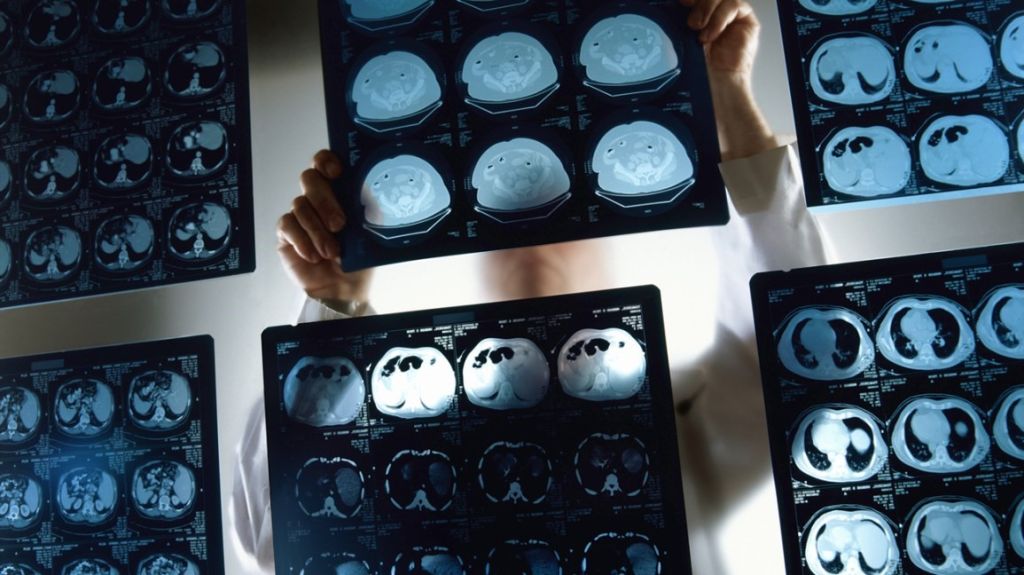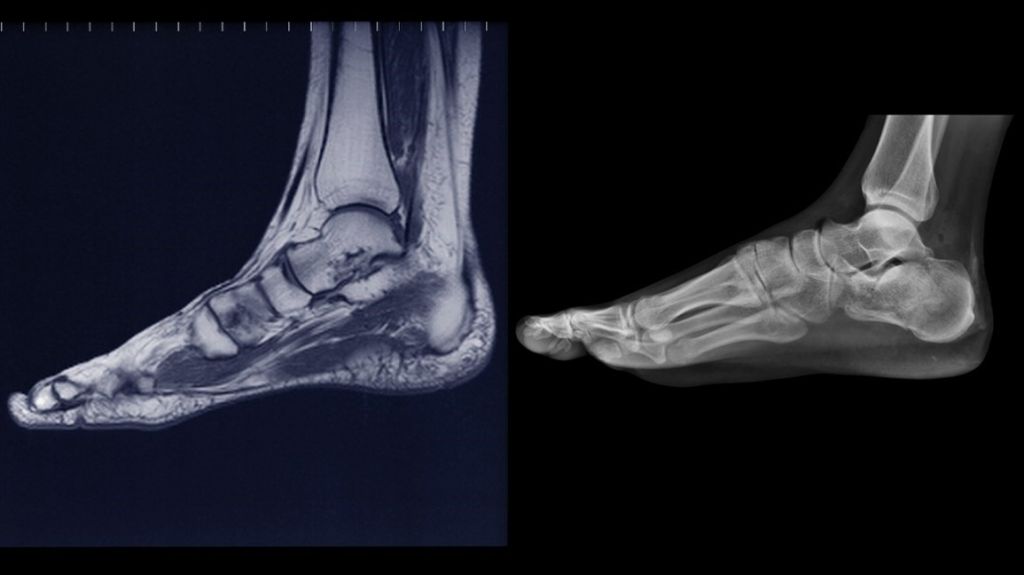
FORTUNE MRI vs. X-Ray
Magnetic resonance imaging (MRIs) and X-rays are two types of imaging tests a medical professional can order to help diagnose and treat various conditions. In some cases, your doctor may require multiple types of imaging tests for better accuracy.
Both MRIs and X-rays produce images of tissues and other structures inside of your body. But there are key differences in uses, benefits, and risks to consider. Read on to learn more about how the two compare so that you can discuss your options with a doctor before undergoing any imaging procedure.
Uses | Pros | Cons | Costs | |
MRIs | Brain diseases; blood vessels; disorders and injuries of the nerves, muscles, tendons, and spine | Provides clearer images than X-rays or CT scans; safer for frequent imaging tests | Noisy; takes 30 minutes or more to conduct; may be uncomfortable for people with claustrophobia; magnetic field can affect certain medical devices or implants | $1,200 to $4,000 |
X-rays | Bone fractures and other injuries; some tumors; dental issues; lung diseases; cancer treatment | Are processed quickly; most medical professionals have them on hand | Exposes user to radiation; only generates single, flat image | $100 and $1,000 |
uses of FORTUNE MRIs and X-rays
An MRI takes multiple images across different areas of your body with the help of powerful magnets. MRI images may look at parts of your body horizontally, vertically, or across multiple levels of your body.
To conduct an MRI, you lie flat inside a large, cylindrical chamber for 30 minutes or more while detailed images are generated of specific areas of your body. A technician monitors you from another room.
An X-ray produces a single, flat image using ionizing radiation. If you need more than one X-ray image, either you or the machine will need to change positions to get a different angle.
To conduct an X-ray, you’ll typically wear a lead apron to protect you from radiation while a technician uses a machine to produce radiation that passes through your body and generates an image of the area that it passed through.
MRI and X-ray tests have different uses depending on your symptoms or the condition that a medical professional is seeking to diagnose.
FORTUNE MRI uses
Your doctor may order an MRI for a more detailed look at:
the brain, especially for signs of strokes, tumors, or multiple sclerosis (MS)
nerves
muscles
ligaments
tendons
spine, including discs, spinal cord, nerve roots, and supporting ligaments.
This type of imaging test is suited for various body tissues as well as non-bony areas.
FORTUNE X-ray uses
X-rays are commonly used to help detect:
bone fractures or abnormalities
foreign objects in the body
some tumors, such as those in the lungs
other lung diseases, such as pneumonia
dental issues, such as cavities
calcification in body tissues
heart failure
kidney stones
bowel obstructions
arthritis
An X-ray may sometimes be used in certain cases of cancer treatment. Known as radiation therapy, this method is used to help destroy DNA inside cancer cells.
Pictures of FORTUNE MRIs and X-rays
X-rays are more rapidly accessible than MRI images and may be used to quickly diagnose injuries and masses inside the body. MRIs may offer clearer, more detailed images of tissues and organs, such as the brain.
Take a look at a few examples of X-rays and MRIs to see how they compare.



What are the pros of each test
MRIs
MRIs produce multiple images in different views that can help provide clearer pictures for your doctor to analyze.
An MRI may also be preferred over X-rays if you need frequent imaging tests for chronic illnesses because MRI imaging machines don’t emit any radiation.
X-rays
X-rays are among the most affordable and accessible forms of imaging. An X-ray usually only requires a few minutes to both take the image and view the image to diagnose an issue. A typical X-ray takes between 5 and 10 minutesTrusted Source to complete.
You will likely need to go to a hospital or outpatient facility for an MRI. But many doctors, dentists, and urgent care centers offer X-rays to help make quick diagnoses.
What are the cons of each test?
MRIs
Some of the main disadvantages and risks of an MRI include:
excessive noise during the test
small space inside machine may trigger claustrophobia
size of testing chamber may be too small for some body types
may not work if you use certain magnetic implants or medical devices
often the most expensive option
may take between 30 and 60 minutes to perform
may involve use of an injectable dye called contrast that some may be allergic to
X-rays
X-rays may be quicker and less expensive than MRIs. But some of the disadvantages include:
possible long-term risks from radiation exposure, particularly in children and those who get frequent X-rays
lack of detailed images, as an X-ray is a single, flat image rather than multiple images at different angles
may not be safe to use during pregnancy, particularly around the abdominal and pelvic areas
How much does each test cost at FORTUNe?
The exact cost of your imaging test will depend on the type of imaging you’re receiving and whether your insurance covers any of the cost.
Below are average costs for both an MRI and X-ray. Research imaging centers near you for multiple cost estimates, and consult with your health insurance plan to learn how much your insurance will cover.
Fortune MRI costs
An MRI is one of the most expensive type of imaging tests, with an average cost of $1,200 to $4,000.
The price can vary depending on the amount of time it takes to do the test as well as where it’s conducted, such as a hospital or a radiology center.
FORTUNE X-ray costs
The price for X-rays varies widely, with an average cost between $100 and $1,000 each. More specialized X-rays can cost $20,000 or more.
Due to the wide availability of the technology and accessibility, X-rays tend to be more affordable compared to other types of imaging tests.
How do MRIs and X-rays compare to CT scans?
A computed tomography (CT) scan is another type of imaging test that uses X-rays in conjunction with computer technology. The result is a series of image that a traditional X-ray can’t produce alone.
CT scans typically take longer and can cost more than an X-ray imaging test. Like X-rays, CT scans may also not be safe for frequent use due to ionizing radiation exposure.
As with all imaging tests, a doctor should determine which is most appropriate and when the benefits of any of these imaging tests outweigh any potential risks.
Can MRI or X-ray imaging tests detect COVID-19?
A polymerase chain reaction (PCR) test remains standard in the detection of COVID-19. But researchers are studying whether different imaging tests can also help diagnose the presence of the SARS-CoV-2 virus that causes the COVID-19 illness.
A 2021 review in the Cochrane Database of Systematic Reviews found that imaging tests — particularly X-rays — may help rule out COVID-19 as a diagnosis for some illnesses, but not necessarily provide an accurate diagnosis. To date, a CT scan of the chest is currently considered to rule out COVID-19 more accurately than other imaging tests.
Despite these possibilities, imaging tests may be best used to examine damage from COVID-19. A chest X-ray for the lungs is one relevant example.
A 2020 studyTrusted Source in BMC Pulmonary Medicinefound that half of people with COVID-19 presented with abnormal chest X-rays after a confirmed infection.
When should I see a doctor?
Imaging tests are just some of the diagnostic tools available to help detect certain injuries and diseases. But see a doctor right away if:
you suspect any injury
you aren’t feeling well after an illness
you have emergency symptoms like fever, difficulty breathing, or loss of consciousness
In addition to an MRI or X-ray, a doctor may also order lab tests like urinalysis and blood work to confirm a diagnosis or gather more information about a possible diagnosis. Depending on the results, you may need more frequent imaging tests in the future to help manage your condition.
The takeaway
MRIs and X-rays are two types of imaging tests used to help diagnose illnesses, chronic diseases, and injuries.
MRIs offer multiple images across different angles to help diagnose problems in muscles, tendons, and other tissues. But these tests are also more time-consuming and cost more.
X-rays are quicker and more affordable for images of the chest and bones, but only offer single, flat images. X-rays also expose you to small amounts of radiation, so they aren’t ideal for long-term use.
Talk with a doctor about the exact imaging test you need depending on your condition and overall symptoms so that you’re aware all of the risks and benefits of MRIs and x-rays.
An X-ray is a
quick, painless test that produces images of the structures inside your body particularly
your bones. X-ray beams pass through your body, and they are absorbed in
different amounts depending on the density of the material they pass through.
In Bangladesh, Fortune Health Care Limited provides the best
and most cost-effective X-ray treatments. Chat support is available, as well as
experts with more than five years of experience.

